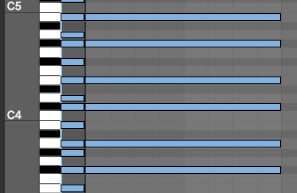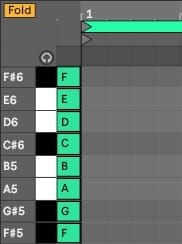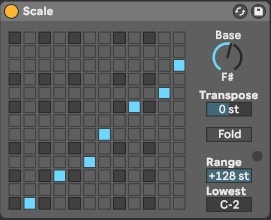Future Bass Chord Progressions for Beginners
Making awesome Future bass chord progressions is possibly one of the hardest things to achieve if you have no musical background. Lucky for us there are some basic rules we can follow to help us understand what’s involved. Let’s take a look at these 10 tips on future bass chord progressions.
Want awesome chord progressions the easy way? Check out our HUGE list of free MIDI files HERE. P.S. There is a surprise for you there.
Future Bass Chord Progressions for Beginners
- Pick a scale
- Add 5th, 7th, 9th and 11th
- Inversions
- Spread chords
- Cadence Chords
- Create suspension
- Change your progression
- Fold piano roll
- Use ‘Scale’ MIDI effect
- Summary
Most future bass chord progressions can be broken down into a basic chord structure. If we understand how this basic structure works, then we can repeat the process and make our own future bass chord progressions using the same techniques.
Let’s take a closer look at the following 9 steps.
1. Pick a scale
When choosing a scale, you want to consider the vibe of your song. Do you want it to feel sad and depressing? Or do you want it to feel happy and joyful?
- Minor scales generally portray a sad vibe.
- Major scaled generally express a happy vibe.
There are many other scales out there but these two are a good starting point.
There are simple formulas we can use to work out the minor and major scales.
Minor scale – WHWWHWW
Major scale – WWHWWWH
‘W’ = 2 semitones or one full note
‘H’ = 1 semitone or half of note
For example:
- F# minor scale would be: F# G# A B C# D E
- F# major scale would be: F# G# A# B C# D# F
Each of the notes in the scale is allocated a number. 1 through to 7. We will talk more about this in the next chapter.
Tip: Generally, most future bass tracks are in a minor scale. Some common future bass chord progression scales are F# minor and G# minor.
2. Add 7th, 9th, and 11th
As we mentioned before, each note in a scale has an allocated number. 1 is the root note. Once you have reached 7, the scale starts at 1 again only up one octave.
When counting out your 7th 9th and 11th chords we do not reset the scale back to 1 on the new octave. We keep counting, following the scale formula.
Generally, a chord is made up of 3 notes. This is called a triad. Typical triads use the 1st 3rd and 5th from any note in the desired scale.
But these triads can sound hollow and not full enough for future bass chord progressions. This is where we can choose to add more notes to our triad.
We can add 7th 9th 11th 13th notes to fill out the spectrum and come up with interesting chord progressions.

3. Inversions
Inversions are quite basic. It is simply shifting the desired notes from your chord up or down an octave.
A common technique is to shift the 5th down one octave. You can experiment on all the other notes in your chord until you find something you like.
Tip: To achieve that full future bass sound you need to have notes from your chord playing over several octaves. Seven Lions, Flume and Illenium use this technique and have notes playing over 4 or 5 octaves.
4. Spread chords
Another way to help your chords sound full is by adding space in between your notes. Now we have learned about inversions, try and move other notes up or down an octave and get some notes playing on at least 4 or 5 octaves.

Tip: Having too many notes close to one spot will grab your attention. You can use this to make draw the listeners attention.
5. Cadence Chords
Now we understand how to make a single chord, let’s talk about how to turn that chord into a chord progression.
Every note in your scale can be turned into a chord using the 1st 3rd and 5th. And as every note was allocated a number from 1 – 7, every chord is allocated a roman numeral. I, II, III, IV, V, VI, VII.
Certain chords have specific feelings. The I chord has a comfortable home feeling, while the IV and V chords have a sound that helps emphasize that home feeling. That makes the chords IV and V cadence chords.
Cadence chords are chords that make that section of the song feel complete and finished. Future bass chord progressions do you cadence chords but in a limited way.
6. Create suspension
Future bass chord progressions create a lot of suspense and rarely land on the I. They will bounce around II, III, VI and VII to help build that suspense.
After a long time, they will eventually land back on the I to satisfy that home feeling in the listener.
Tips: Use the II, III,VI, and VII more than I, IV, and V. This will create more suspense in your track. For example. III, VI, II, VII, III, VI, V,IV.
7. Change your progression
Change is always a good thing. It’s important to keep the listener interested with slight changes.
Changes can be in the form of a complete chord change or even just a few notes in a chord progression.
Changing the timing of your chords is very important.
Look at my example below.
Tips: Try different chord inversions in different chords. Experiment with changing 1 chord out of a whole chord progression rather than the whole chord progression. Or even try changing the order of chords.
8. Fold piano roll
Ableton makes it super easy for the average person to pencil in chords even if they don’t understand music theory.
An easy way to do this is to pencil in the notes from your scale and move them outside your looped section. Copy them all and paste them over 4 or 5 octaves. Then hit the fold button to hide all the other notes.

This is a great option if you want to pencil in your chord progressions rather than play them.
Tips: Fill in one octave of your scale and drag it out of the loop section. Then copy all those notes. Press ‘Shift + up’ to move the notes up one octave and then paste with ‘Ctrl + v’. Repeat this process until you have your scale over 4 or 5 octaves.
9. Use ‘Scale’ MIDI effect
There is even a built-in option into Ableton that allows the inexperienced musician to play their chords progressions using only the white notes on your MIDI controller.
The MIDI effect called ‘Scale’ is perfect for this.
Simply drag an instance of ‘scale’ onto your MIDI track and change the base note to the root note of your scale.
The vertical columns with no black dots are the white keys, and ones with the black dots are black keys.
The horizontal rows are semitones.
Fill out the white columns using your scale formula.

Now when you play the white notes on your MIDI only the notes from your scale will be heard.
Sidechain
Last but not least, we have sidechain compression. I have a full guide to sidechain compression with audio samples you can view HERE.
So for those of you who are not familiar with sidechain compression, let me explain.
Sidechain compression is when one signal reduces the gain of another signal.
For example. A kick can reduce the volume of a synth patch right when the kick hits. This is what creates a pumping feeling in your music and it also makes room for your kick to sit nicely in your mix.
You can even mute your kick and use sidechain compression to give the synth a nice ducking sound. Lots of future bass producers use this technique to add some rhythm to their chord progressions.
If you want to add heavy sidechain compression to your music, copy the settings from the image below.

Raising the ‘Threshold’ control will reduce the sidechain effect.
Summary
Future Bass is an amazing genre filled with amazing harmonically pleasing chords and melodies. It’s quite difficult to learn but when you do it will make learning other genres easier.
I recommend you watch my future bass/future pop tutorial and see exactly what goes into making a future bass song from start to finish. You can even get the Ableton project files for free!
I hope these tips serve you well.
Check out some of my other future bass stuff:
- 10 small future bass record labels you can easily approach
- 15 Essential tips for producing future bass
- Electronic Music Theory For Beginners
Good luck and happy producing.